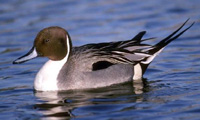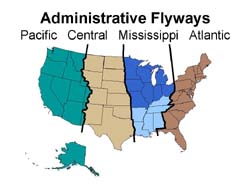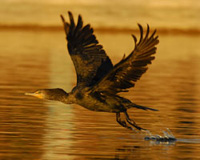|
Jurisdiction
The federal governments of the United States, Canada,
and Mexico, under the authorities of bilateral treaties and federal
legislation, are ultimately responsible for the protection and
conservation of migratory birds in North America. In the United States,
this responsibility has largely been delegated to the U.S. Fish and
Wildlife Service. The Migratory Bird Treaty Act authorizes state
governments to adopt and enforce laws and
 regulations protecting migratory birds, as long as they aren't
inconsistent with those of the federal government. That is, state
authority may be more restrictive than the federal authority, but not
more liberal. Each state has constitutional and legislative mandates
and a body of laws and regulations that direct the conservation and
public uses of migratory game birds within their borders.
regulations protecting migratory birds, as long as they aren't
inconsistent with those of the federal government. That is, state
authority may be more restrictive than the federal authority, but not
more liberal. Each state has constitutional and legislative mandates
and a body of laws and regulations that direct the conservation and
public uses of migratory game birds within their borders.
Biological Flyways
Hunters, by returning the bands they've found on the
legs of ducks and geese they harvest, have helped identify the migration
patterns of waterfowl through the continent. Biologists proposed in the
mid-1930s that migratory birds followed four geographical flyways during
their spring and fall migrations across North America. East to west,
the flyways are the Atlantic, Mississippi, Central, and Pacific.
Flyway is a useful geographic term that describes four regions of the
United States. Although migratory birds fly through many narrow migration
corridors, the flyways fairly accurately represent the major north-south
migration pathways. (Download a
Pacific,
Central,
Mississippi, or
Atlantic flyway map; 188 to 200
KB PDF files).
Administrative Flyways
Because of the unique biological characteristics and
relative number of hunters in the flyways, the Service adopted the flyway
 structure in 1947 for administering migratory bird resources within the
United States. Although biological flyways extend through North America,
administrative flyways are specific to the United States. The Mississippi
flyway is further divided into north and south regions.
structure in 1947 for administering migratory bird resources within the
United States. Although biological flyways extend through North America,
administrative flyways are specific to the United States. The Mississippi
flyway is further divided into north and south regions.
State Involvement
States have always played an essential role in the
protection and conservation of migratory birds and their habitats at
regional and locals level. Over the past 50 years, states increasingly
have become involved in research and management of migratory game birds on
a broader scale. With increased state participation came a demand for a
greater role in the federal regulation of migratory game birds. States
also recognized the need for greater coordination and cooperation of
efforts to improve biological and ecological information on migratory
birds, exchange of that information among biologists and managers from
different geographic areas, and consistency in harvest regulations.
After several years of working in the flyway system, states decided they
could more effectively achieve their objectives by organizing by flyways
rather than operating individually. In 1951, the
Association of Fish and Wildlife
Agencies passed a resolution recommending the establishment of a flyway
council in each flyway that would be composed of representatives of the
state wildlife agencies, and a national flyway council consisting of one
elected member from each flyway council. Further, one representative of
the Service was to serve as a liaison officer for each council to help
coordinate state and federal programs.
Flyway councils were established in 1952 and the national council in 1953.
Flyway councils may include representatives from state, province, and
federal governments in
 the United States, Canada, and Mexico, but only U.S.
state wildlife agencies vote on regulatory matters in the United States.
Flyway councils serve as the forum for increased cooperation in the
management of migratory game between the states and the U.S. Fish and
Wildlife Service, but also among public wildlife conservation agencies in
the United States, Canada, and Mexico. Establishment of the flyway councils
increased state coordination and participation in monitoring, data
evaluation, research, habitat protection, management, and regulation setting
for migratory birds in North America.
the United States, Canada, and Mexico, but only U.S.
state wildlife agencies vote on regulatory matters in the United States.
Flyway councils serve as the forum for increased cooperation in the
management of migratory game between the states and the U.S. Fish and
Wildlife Service, but also among public wildlife conservation agencies in
the United States, Canada, and Mexico. Establishment of the flyway councils
increased state coordination and participation in monitoring, data
evaluation, research, habitat protection, management, and regulation setting
for migratory birds in North America.
Each flyway council generally has three technical committees including a
waterfowl, upland game bird, and a nongame bird technical committee. The
technical committees may include representatives from state, province, and
federal governments in the United States, Canada, and Mexico, but only U.S.
state wildlife agencies vote on regulatory matters in the United States. A
biologist from a state or province may serve on more than one technical
committee within a flyway. The technical committees function to develop
cooperative programs and management plans and to formulate recommendations
to the council pertaining to the research and management of migratory birds.
Flyway waterfowl and upland game bird technical committees were generally
established in 1952 when the councils were created, and the flyway nongame
bird technical committees were established in 2006.
Pacific Flyway Council
Members of the council include one representative, the
director or an appointee, from each state or provincial wildlife agency
in the western United States, Canada, and
 Mexico. In the United States,
this includes Alaska, Arizona, California, Idaho, Nevada, Oregon, Utah,
Washington, and those portions of Colorado, Montana, New Mexico, and
Wyoming west of the Continental Divide (presently, New Mexico chooses not
to be an active member of the Pacific Flyway Council). The federal
governments of the United States, Canada, and Mexico, and Alaska
subsistence harvest management bodies may provide an ex officio
representative to the Council. Only U.S. state members vote on U.S.
regulatory matters.
Mexico. In the United States,
this includes Alaska, Arizona, California, Idaho, Nevada, Oregon, Utah,
Washington, and those portions of Colorado, Montana, New Mexico, and
Wyoming west of the Continental Divide (presently, New Mexico chooses not
to be an active member of the Pacific Flyway Council). The federal
governments of the United States, Canada, and Mexico, and Alaska
subsistence harvest management bodies may provide an ex officio
representative to the Council. Only U.S. state members vote on U.S.
regulatory matters.
Two members of the Council, one from the interior states and one from
the coastal states, are elected to serve as consultants to the U.S. Fish
and Wildlife Service's Migratory Bird Regulation Committee. One member of
the Council is elected to serve on the National Flyway Council and the
International Association of Fish and Wildlife Agencies' Migratory
Wildlife Committee.
The Pacific Flyway Council has two technical committees including a game
bird technical committee and a nongame bird technical committee. The game
bird technical committee deals with both waterfowl and upland game bird
issues, unlike other flyways, where these issues are addressed by separate
technical committees. Membership of each technical committee includes one
representative from each state or provincial wildlife agency in the western
United States, Canada, and Mexico. This includes Alaska, Arizona, California,
Colorado, Idaho, Montana, Nevada, New Mexico, Oregon, Utah, Washington, and
Wyoming in the United States. The Pacific Flyway game bird technical committee
is called the Pacific Flyway Study Committee and the nongame bird technical
committee is called the Pacific Flyway Nongame Migratory Bird Technical
Committee.
The Council is a policy and regulation setting body whereas the Study
Committee and Nongame Migratory Bird Technical Committee are scientific
fact finding bodies. All three are governed by
bylaws.
A historical account of the Pacific Flyway Council and Study Committee,
including their establishment, was prepared by James C. Bartonek in 1981
(The Pacific Flyway Study Committee and
Council: A History, 120 KB PDF file). Mr. Bartonek was the U.S. Fish and
Wildlife Service's Pacific Flyway Representative from 1978 to 1995.
Photo credit: northern pintail, photographer unknown; cormorant, G. Andrejko;
white-winged dove, G. Andrejko.
|



